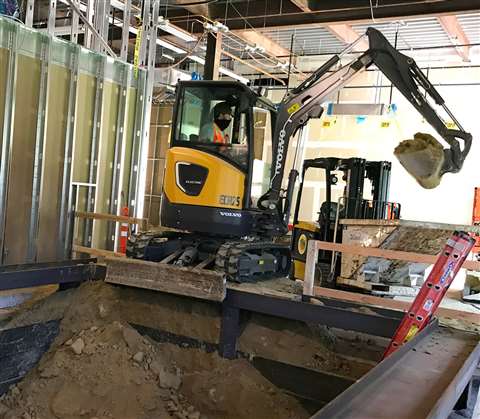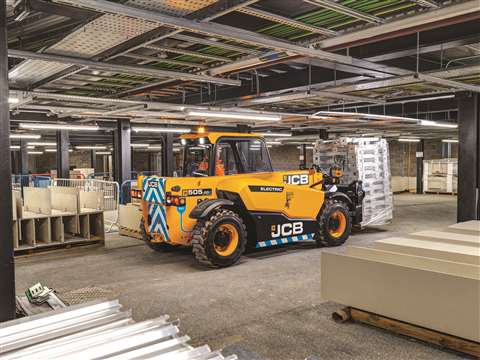Emissions, noise drive compact equipment electrification
10 August 2022
 Construction is leading the way in electric equipment adoption. Here, Casper Co., a family-owned construction business in San Diego, uses a Volvo ECR25 Electric compact excavator for work inside of occupied buildings where noise and exhaust fumes are a major concern. (Photo: Volvo Construction Equipment)
Construction is leading the way in electric equipment adoption. Here, Casper Co., a family-owned construction business in San Diego, uses a Volvo ECR25 Electric compact excavator for work inside of occupied buildings where noise and exhaust fumes are a major concern. (Photo: Volvo Construction Equipment)
Battery electric power has achieved a substantial foothold in compact equipment. While equipment types vary, in surveying the market, battery technology provider Kreisel Electric identified residential turf care products, compact construction equipment on up to small tractors as initial targets for utilizing electric power systems.
Jennifer Preston, director of John Deere Electric Powertrain, CEO, Kreisel Electric, said experiences in the on-highway market “have undoubtedly played a role in helping customers get used to [BEV] technology and helped grow the acceptance rate in off-highway markets.”
“It is becoming clear that the more electric-powered cars and trucks that are purchased, the more it makes sense for consumers to go electric for residential and rural lifestyle applications, as well,” she said. “Once the charging infrastructure is on their property, customers start to think about what else they could do with that electrical power.”
Construction leads charge
But while there has been a sizable shift in the lawn and garden markets toward electric power, Nick Moore, director of product management for Electrification, Briggs & Stratton, said construction is the industry leading the charge in adoption. “We’ve seen huge interest from the construction market due to green jobsite requirements and the demand for low-emissions solutions for indoor work,” he said. “The ability to run a piece of equipment indoors or out, as well as the ability to meet all jobsite requirements without sacrificing performance, makes battery power a beneficial choice.”
READ MORE: Compacts Lead Charge in Off-highway Electrification
“The machines are used in all of the same applications that diesel machinery is used, plus many places diesel machinery cannot be, such as indoor applications, underground or applications that are in close proximity to food and animals,” said Ashby Graham, general manager - production & marketing, JCB. “As well, customers can extend the working hours of machinery on jobsites that have noise level restrictions such as schools and hospitals.
“Our electric equipment is being used in applications we expected with people who are interested in reducing their carbon footprint or work in noise-sensitive environments,” she continued. “But they’re also being used in applications we didn’t necessarily expect, such as inside recycling centers as a stationary sorting machine; cleaning out culverts under the interstate with no requirement for exhaust extraction equipment or road closures; and dairy farms and nurseries because the equipment does not impact the animals or plants.”
 JCB 505-20E electric compact telehandler (Photo: JCB)
JCB 505-20E electric compact telehandler (Photo: JCB)
Understanding needs & applications
Joel Honeyman, vice president of Global Innovation, Bobcat Co., sees electric power as yet another option to meet specific customer and jobsite needs. “I want to be really clear, and I do want to make this statement: We are not getting rid of diesel machines tomorrow,” he said. “It is a both/and world.
“There will be diesel machines for many years,” he added. “However, there is a segment of customers… that want and appreciate what an electric machine can provide. And there are applications and customers who are demanding this, so we’re going to provide that.”
Working alongside early adopters has been valuable in understanding both these customers’ needs and the applications, said Graham. “While they get on-site expertise, we’re getting first-hand feedback that allows us to explain best practices for how electric machines should be used, especially when integrated with an existing diesel-powered fleet,” she noted. “Customer feedback also helps us assess machine performance in unique environments, like operating in sand, and how that might impact things like power usage over time.
“Electric is opening the doors to new opportunities, which is exciting,” she said. “It also brings some unknowns, which we learn from to adapt for optimal performance in future.”
STAY CONNECTED



Receive the information you need when you need it through our world-leading magazines, newsletters and daily briefings.
CONNECT WITH THE TEAM








